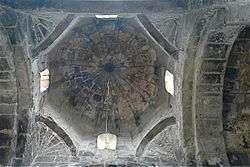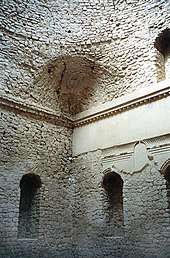Squinch
In architecture, a squinch is a construction filling in (or rounding off) the upper angles of a square room so as to form a base to receive an octagonal or spherical dome. Another solution to this structural problem was provided by the pendentive, commonly used in Western architecture.

Construction

Squinches may be formed by masonry built out from the angle in corbelled courses, by filling the corner with a vise placed diagonally, or by building an arch or a number of corbelled arches diagonally across the corner.
History in the Middle East
The dome chamber in the Palace of Ardashir, the Sassanid king, in Firuzabad, Iran is the earliest surviving example of the use of the squinch, suggesting that the squinch may have been invented in Persia.[1] After the rise of Islam, it was used in the Middle East in both eastern Romanesque and Islamic architecture. It remained a feature of Islamic architecture, especially in Iran, and was often covered by corbelled stalactite-like structures known as muqarnas.
History in Western Europe
It spread to the Romanesque architecture of western Europe, one example being the Normans' 12th-century church of San Cataldo, Palermo in Sicily. This has three domes, each supported by four doubled squinches.
Etymology
The word may possibly originate, the Oxford English Dictionary suggests, from the French word escoinson, meaning "from an angle", which became the English word "scuncheon" and then "scunch".[2][3]
References
- Robert Byron, The Road to Oxiana
- "definition of Squinch". Oxford Living Dictionaries. Retrieved 11 March 2018.
- "The definition of squinch". Dictionary.com. 2015. Retrieved 2015-10-24.
